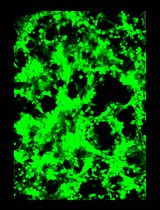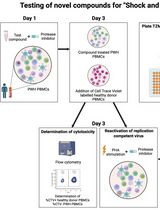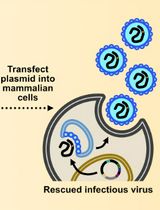Materials and Reagents
- CD4+ T cell line H9 cells (ATCC HTB-176 )
- Fetal bovine serum (FBS) (Thermo Fisher Scientific, catalog number: SH30071.03 HI )
Note: This particular FBS has been tested by the author, but may be substituted with FBS from different suppliers as desired by users.
- Penicillin-Streptomycin liquid (Life Technologies, Gibco®, catalog number: 15070-063 )
- Cell culture media: RPMI1640 (Life Technologies, Gibco®, catalog number: 11875-093 ) (see Recipes)
Equipment
- Bench-top centrifuges
- CO2 incubator
- -80 °C freezer
- 50 ml conical tubes (BD Biosciences, Falcon®, catalog number: 35-2070 )
- 5, 10, 25-ml pipet (BD Biosciences, Falcon®, catalog number: 35-7501 , 35-7554 , 35-7556 )
- T-75, T-175 cell culture flask (BD Biosciences, Falcon®, catalog number: 35-3136 , 35-3112 )
- CryoTube Vials (NUNC, 377267)
Procedure
Day 1
- Dilute 2 x 106 uninfected H9 cells in 2 ml of culture medium (final concentration 1 x 106 cells/ml) in a 50-ml falcon tube.
- Add 1 ml of HIV-1 virus (IIIB strain) to the falcon tube.
- Shake gently every 15 min for 1 h.
- Pipet this miniculture into 50 ml of culture medium in a T-75 cell culture flask.
- Incubate at 37 °C for 4 days.
Day 5
- Add 175 ml fresh media to each of 2 new large falcon T-175 cell culture flasks.
- Add 25 ml of 4-day culture to each flask.
- Incubate at 37 °C for 3 days.
Day 8
- HIV-1 infected cells (400 ml) were transferred into 10 x 50-ml falcon tubes using a 25-ml pipet (40 ml per tube).
- Centrifuge in secondary containers at 1,300 rpm for 8 min.
- Carefully remove supernatant using the vacuum line with pipet tip attached to a 10-ml pipet (fill collection flask with bleach).
- Add 2 ml of fresh media to each tube and loosen the cell pellets.
- Collect all cells in 2 tubes and rinse the other 8 tubes with fresh media and add into those 2 tubes.
- Add fresh media to each of these 2 tubes to a final volume of 40 ml.
- Centrifuge in secondary containers at 1,300 rpm for 8 min.
- Remove supernatant.
- Add 10 ml of fresh media to each flask and loosen cell pellet.
- Combine into one tube.
- Beat up cells for 20 sec using tube rack.
- Centrifuge in secondary containers at 2,000 rpm for 8 min.
- Transfer supernatant using pipet into a fresh 50-ml falcon tube (Supernatant 1).
- Add 10 ml of fresh media to tube with cell pellet and loosen cell pellet.
- Beat up cells again using tube rack.
- Centrifuge in secondary containers at 2,000 rpm for 8 min.
- Transfer supernatant using pipet into a fresh 50-ml falcon tube (Supernatant 2).
- Tranfer Supernatant 1 and 2 into small CryoTube vials using a 5-ml pipet (1 ml each tube) (label tubes with IIIB, date and either Sup1 or Sup 2).
- Store in -80 °C freezer.
Notes
The experiment using HIV-1 needs to be done in a BSL-3 lab and the personnel require special training for working with HIV-1 virus.
Recipes
- Culture medium (500 ml)
RPMI1640 medium
| 500 ml
|
FBS
| 50 ml
|
Penicillin-streptomycin
| 5 ml |
Acknowledgments
The author thanks Dutschman, GE and Dr. Yung-Chi Cheng at the Department of Pharmacology, Yale School of Medicine for the adaptation of this method and their support on the research of anti-HIV-1 drug development.
References
- Dutschman, G. E., Grill, S. P., Gullen, E. A., Haraguchi, K., Takeda, S., Tanaka, H., Baba, M. and Cheng, Y. C. (2004). Novel 4'-substituted stavudine analog with improved anti-human immunodeficiency virus activity and decreased cytotoxicity. Antimicrob Agents Chemother 48(5): 1640-1646.
Article Information
Copyright
© 2012 The Authors; exclusive licensee Bio-protocol LLC.
Category
Microbiology > Microbe-host interactions > Virus
Microbiology > Microbial cell biology > Cell isolation and culture











